GMC CANYON 2021 Workshop Manual
Manufacturer: GMC, Model Year: 2021, Model line: CANYON, Model: GMC CANYON 2021Pages: 359, PDF Size: 7.37 MB
Page 51 of 359
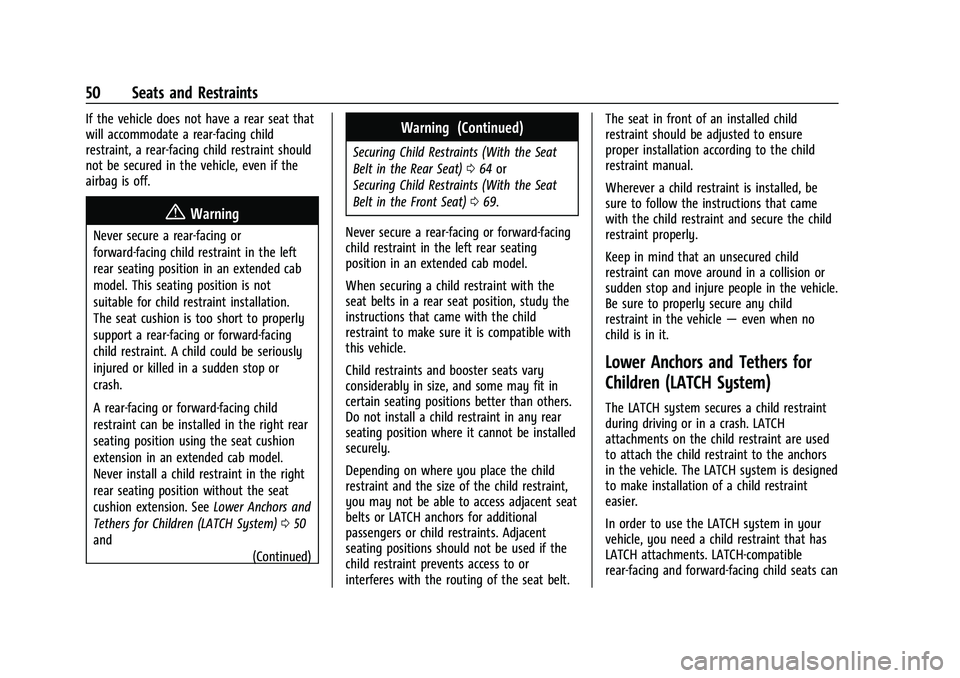
GMC Canyon/Canyon Denali Owner Manual (GMNA-Localizing-U.S./Canada-
14430430) - 2021 - CRC - 9/9/20
50 Seats and Restraints
If the vehicle does not have a rear seat that
will accommodate a rear-facing child
restraint, a rear-facing child restraint should
not be secured in the vehicle, even if the
airbag is off.
{Warning
Never secure a rear-facing or
forward-facing child restraint in the left
rear seating position in an extended cab
model. This seating position is not
suitable for child restraint installation.
The seat cushion is too short to properly
support a rear-facing or forward-facing
child restraint. A child could be seriously
injured or killed in a sudden stop or
crash.
A rear-facing or forward-facing child
restraint can be installed in the right rear
seating position using the seat cushion
extension in an extended cab model.
Never install a child restraint in the right
rear seating position without the seat
cushion extension. SeeLower Anchors and
Tethers for Children (LATCH System) 050
and
(Continued)
Warning (Continued)
Securing Child Restraints (With the Seat
Belt in the Rear Seat)064 or
Securing Child Restraints (With the Seat
Belt in the Front Seat) 069.
Never secure a rear-facing or forward-facing
child restraint in the left rear seating
position in an extended cab model.
When securing a child restraint with the
seat belts in a rear seat position, study the
instructions that came with the child
restraint to make sure it is compatible with
this vehicle.
Child restraints and booster seats vary
considerably in size, and some may fit in
certain seating positions better than others.
Do not install a child restraint in any rear
seating position where it cannot be installed
securely.
Depending on where you place the child
restraint and the size of the child restraint,
you may not be able to access adjacent seat
belts or LATCH anchors for additional
passengers or child restraints. Adjacent
seating positions should not be used if the
child restraint prevents access to or
interferes with the routing of the seat belt. The seat in front of an installed child
restraint should be adjusted to ensure
proper installation according to the child
restraint manual.
Wherever a child restraint is installed, be
sure to follow the instructions that came
with the child restraint and secure the child
restraint properly.
Keep in mind that an unsecured child
restraint can move around in a collision or
sudden stop and injure people in the vehicle.
Be sure to properly secure any child
restraint in the vehicle
—even when no
child is in it.
Lower Anchors and Tethers for
Children (LATCH System)
The LATCH system secures a child restraint
during driving or in a crash. LATCH
attachments on the child restraint are used
to attach the child restraint to the anchors
in the vehicle. The LATCH system is designed
to make installation of a child restraint
easier.
In order to use the LATCH system in your
vehicle, you need a child restraint that has
LATCH attachments. LATCH-compatible
rear-facing and forward-facing child seats can
Page 52 of 359
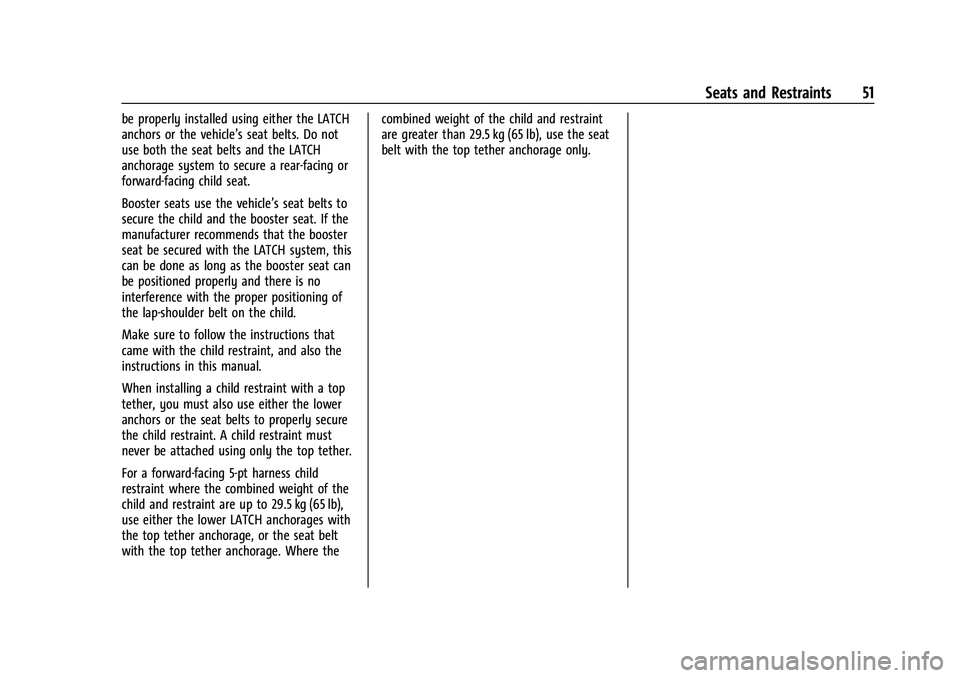
GMC Canyon/Canyon Denali Owner Manual (GMNA-Localizing-U.S./Canada-
14430430) - 2021 - CRC - 9/9/20
Seats and Restraints 51
be properly installed using either the LATCH
anchors or the vehicle’s seat belts. Do not
use both the seat belts and the LATCH
anchorage system to secure a rear-facing or
forward-facing child seat.
Booster seats use the vehicle’s seat belts to
secure the child and the booster seat. If the
manufacturer recommends that the booster
seat be secured with the LATCH system, this
can be done as long as the booster seat can
be positioned properly and there is no
interference with the proper positioning of
the lap-shoulder belt on the child.
Make sure to follow the instructions that
came with the child restraint, and also the
instructions in this manual.
When installing a child restraint with a top
tether, you must also use either the lower
anchors or the seat belts to properly secure
the child restraint. A child restraint must
never be attached using only the top tether.
For a forward-facing 5-pt harness child
restraint where the combined weight of the
child and restraint are up to 29.5 kg (65 lb),
use either the lower LATCH anchorages with
the top tether anchorage, or the seat belt
with the top tether anchorage. Where thecombined weight of the child and restraint
are greater than 29.5 kg (65 lb), use the seat
belt with the top tether anchorage only.
Page 53 of 359

GMC Canyon/Canyon Denali Owner Manual (GMNA-Localizing-U.S./Canada-
14430430) - 2021 - CRC - 9/9/20
52 Seats and Restraints
Recommended Methods for Attaching Child Restraints
Restraint Type Combined Weight ofthe Child + Child
Restraint Use Only Approved Attachment Methods Shown with an X
LATCH
–Lower
Anchors Only Seat Belt Only LATCH
–Lower
Anchors and Top
Tether Anchor Seat Belt and Top
Tether Anchor
Rear-Facing Child
Restraint Up to 29.5 kg (65 lb)
X X
Rear-Facing Child
Restraint Greater than
29.5 kg (65 lb) X
Forward-Facing Child
Restraint Up to 29.5 kg (65 lb)
X X
Forward-Facing Child
Restraint Greater than
29.5 kg (65 lb) X
See Securing Child Restraints (With the Seat
Belt in the Rear Seat) 064 or
Securing Child Restraints (With the Seat Belt
in the Front Seat) 069. Child restraints built after March 2014 will
be labeled with the specific child weight up
to which the LATCH system can be used to
install the restraint.
The following explains how to attach a child
restraint with these attachments in the
vehicle. Not all vehicle seating positions have lower
anchors. In this case, the seat belt must be
used (with top tether where available) to
secure the child restraint. See
Securing Child
Restraints (With the Seat Belt in the Rear
Seat) 064 or
Securing Child Restraints (With the Seat Belt
in the Front Seat) 069.
Page 54 of 359
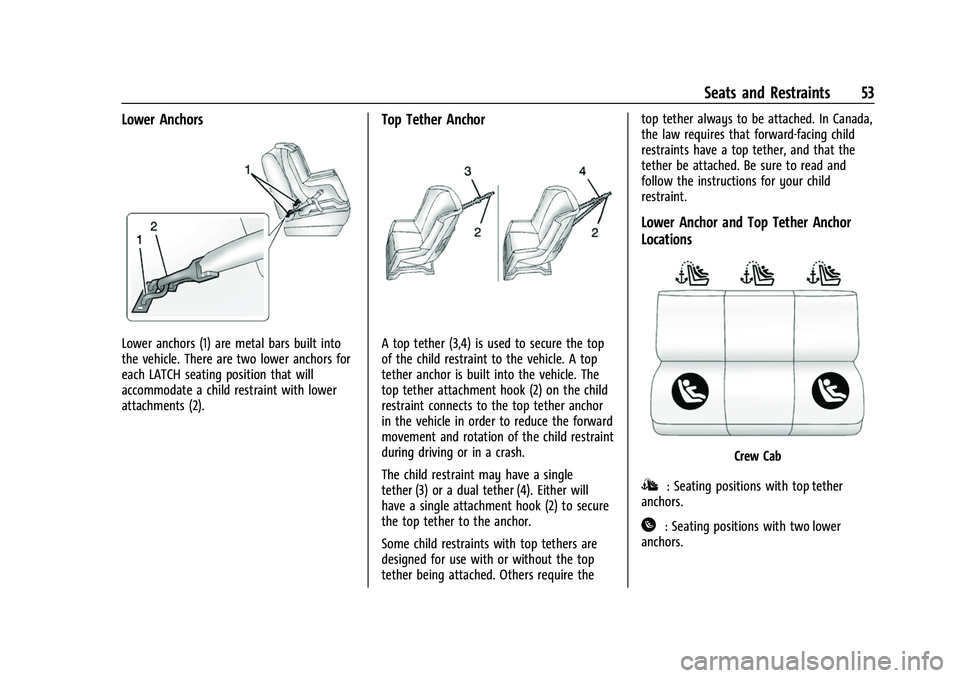
GMC Canyon/Canyon Denali Owner Manual (GMNA-Localizing-U.S./Canada-
14430430) - 2021 - CRC - 9/9/20
Seats and Restraints 53
Lower Anchors
Lower anchors (1) are metal bars built into
the vehicle. There are two lower anchors for
each LATCH seating position that will
accommodate a child restraint with lower
attachments (2).
Top Tether Anchor
A top tether (3,4) is used to secure the top
of the child restraint to the vehicle. A top
tether anchor is built into the vehicle. The
top tether attachment hook (2) on the child
restraint connects to the top tether anchor
in the vehicle in order to reduce the forward
movement and rotation of the child restraint
during driving or in a crash.
The child restraint may have a single
tether (3) or a dual tether (4). Either will
have a single attachment hook (2) to secure
the top tether to the anchor.
Some child restraints with top tethers are
designed for use with or without the top
tether being attached. Others require thetop tether always to be attached. In Canada,
the law requires that forward-facing child
restraints have a top tether, and that the
tether be attached. Be sure to read and
follow the instructions for your child
restraint.
Lower Anchor and Top Tether Anchor
Locations
Crew Cab
I: Seating positions with top tether
anchors.
H: Seating positions with two lower
anchors.
Page 55 of 359
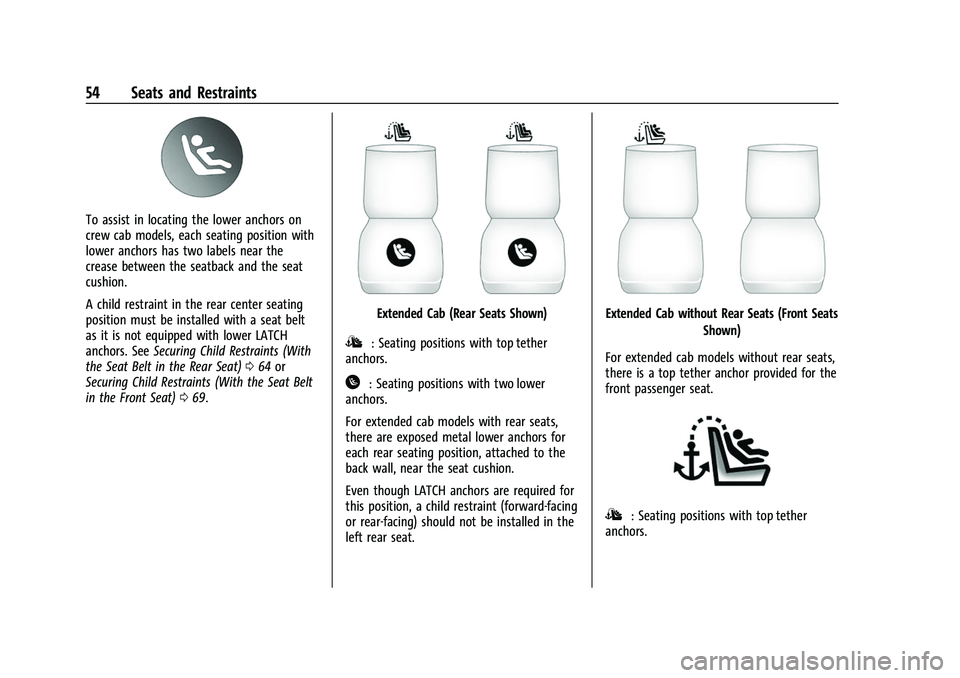
GMC Canyon/Canyon Denali Owner Manual (GMNA-Localizing-U.S./Canada-
14430430) - 2021 - CRC - 9/9/20
54 Seats and Restraints
To assist in locating the lower anchors on
crew cab models, each seating position with
lower anchors has two labels near the
crease between the seatback and the seat
cushion.
A child restraint in the rear center seating
position must be installed with a seat belt
as it is not equipped with lower LATCH
anchors. SeeSecuring Child Restraints (With
the Seat Belt in the Rear Seat) 064 or
Securing Child Restraints (With the Seat Belt
in the Front Seat) 069.
Extended Cab (Rear Seats Shown)
I: Seating positions with top tether
anchors.
H: Seating positions with two lower
anchors.
For extended cab models with rear seats,
there are exposed metal lower anchors for
each rear seating position, attached to the
back wall, near the seat cushion.
Even though LATCH anchors are required for
this position, a child restraint (forward-facing
or rear-facing) should not be installed in the
left rear seat.
Extended Cab without Rear Seats (Front Seats
Shown)
For extended cab models without rear seats,
there is a top tether anchor provided for the
front passenger seat.
I: Seating positions with top tether
anchors.
Page 56 of 359
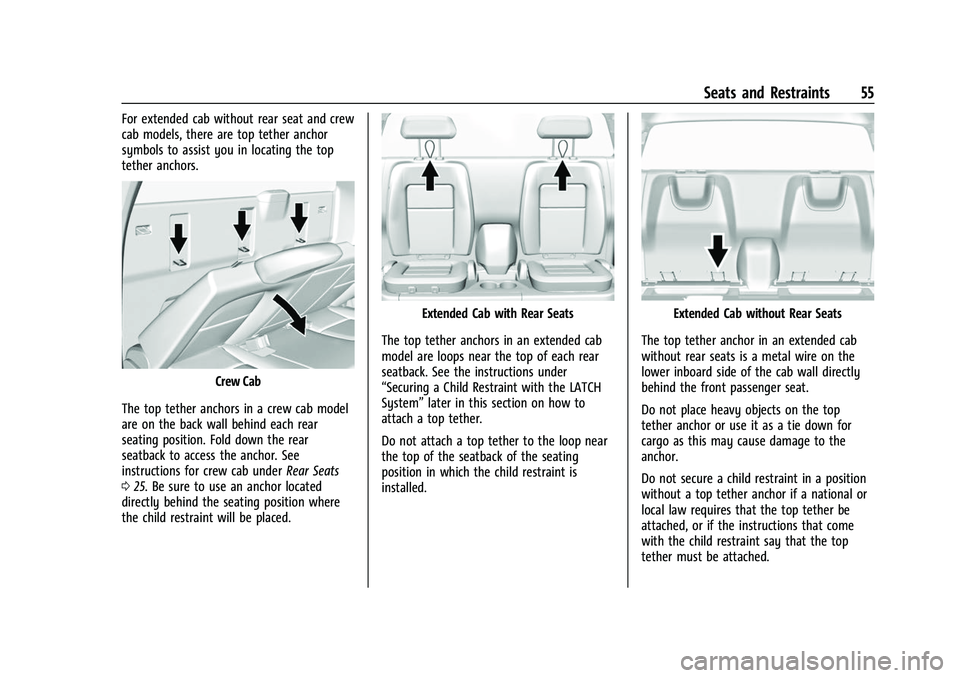
GMC Canyon/Canyon Denali Owner Manual (GMNA-Localizing-U.S./Canada-
14430430) - 2021 - CRC - 9/9/20
Seats and Restraints 55
For extended cab without rear seat and crew
cab models, there are top tether anchor
symbols to assist you in locating the top
tether anchors.
Crew Cab
The top tether anchors in a crew cab model
are on the back wall behind each rear
seating position. Fold down the rear
seatback to access the anchor. See
instructions for crew cab under Rear Seats
0 25. Be sure to use an anchor located
directly behind the seating position where
the child restraint will be placed.
Extended Cab with Rear Seats
The top tether anchors in an extended cab
model are loops near the top of each rear
seatback. See the instructions under
“Securing a Child Restraint with the LATCH
System” later in this section on how to
attach a top tether.
Do not attach a top tether to the loop near
the top of the seatback of the seating
position in which the child restraint is
installed.Extended Cab without Rear Seats
The top tether anchor in an extended cab
without rear seats is a metal wire on the
lower inboard side of the cab wall directly
behind the front passenger seat.
Do not place heavy objects on the top
tether anchor or use it as a tie down for
cargo as this may cause damage to the
anchor.
Do not secure a child restraint in a position
without a top tether anchor if a national or
local law requires that the top tether be
attached, or if the instructions that come
with the child restraint say that the top
tether must be attached.
Page 57 of 359
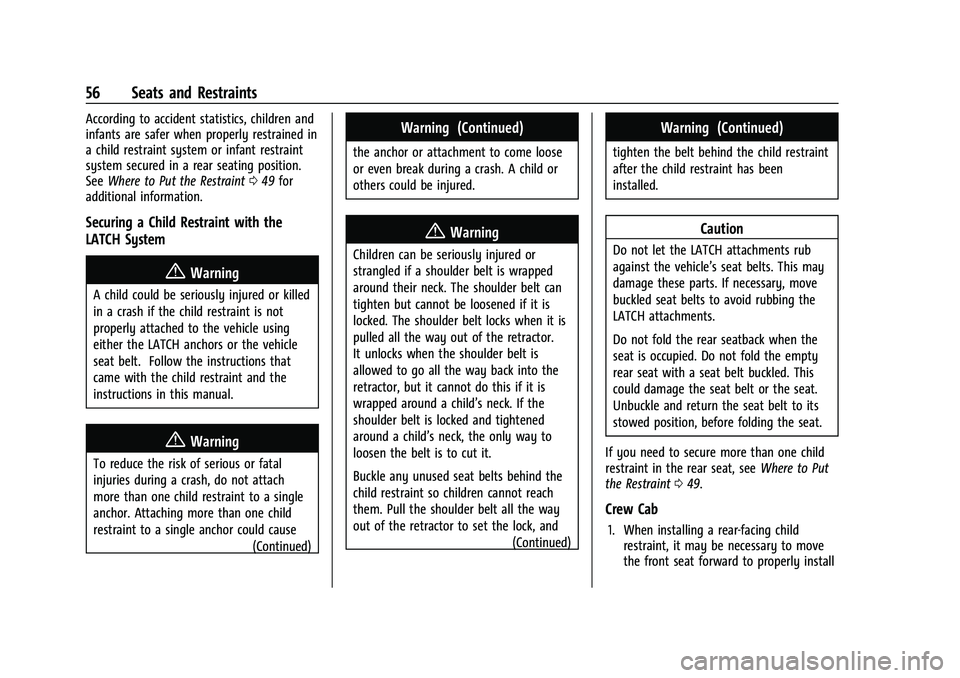
GMC Canyon/Canyon Denali Owner Manual (GMNA-Localizing-U.S./Canada-
14430430) - 2021 - CRC - 9/9/20
56 Seats and Restraints
According to accident statistics, children and
infants are safer when properly restrained in
a child restraint system or infant restraint
system secured in a rear seating position.
SeeWhere to Put the Restraint 049 for
additional information.
Securing a Child Restraint with the
LATCH System
{Warning
A child could be seriously injured or killed
in a crash if the child restraint is not
properly attached to the vehicle using
either the LATCH anchors or the vehicle
seat belt. Follow the instructions that
came with the child restraint and the
instructions in this manual.
{Warning
To reduce the risk of serious or fatal
injuries during a crash, do not attach
more than one child restraint to a single
anchor. Attaching more than one child
restraint to a single anchor could cause
(Continued)
Warning (Continued)
the anchor or attachment to come loose
or even break during a crash. A child or
others could be injured.
{Warning
Children can be seriously injured or
strangled if a shoulder belt is wrapped
around their neck. The shoulder belt can
tighten but cannot be loosened if it is
locked. The shoulder belt locks when it is
pulled all the way out of the retractor.
It unlocks when the shoulder belt is
allowed to go all the way back into the
retractor, but it cannot do this if it is
wrapped around a child’s neck. If the
shoulder belt is locked and tightened
around a child’s neck, the only way to
loosen the belt is to cut it.
Buckle any unused seat belts behind the
child restraint so children cannot reach
them. Pull the shoulder belt all the way
out of the retractor to set the lock, and
(Continued)
Warning (Continued)
tighten the belt behind the child restraint
after the child restraint has been
installed.
Caution
Do not let the LATCH attachments rub
against the vehicle’s seat belts. This may
damage these parts. If necessary, move
buckled seat belts to avoid rubbing the
LATCH attachments.
Do not fold the rear seatback when the
seat is occupied. Do not fold the empty
rear seat with a seat belt buckled. This
could damage the seat belt or the seat.
Unbuckle and return the seat belt to its
stowed position, before folding the seat.
If you need to secure more than one child
restraint in the rear seat, see Where to Put
the Restraint 049.
Crew Cab
1. When installing a rear-facing child
restraint, it may be necessary to move
the front seat forward to properly install
Page 58 of 359
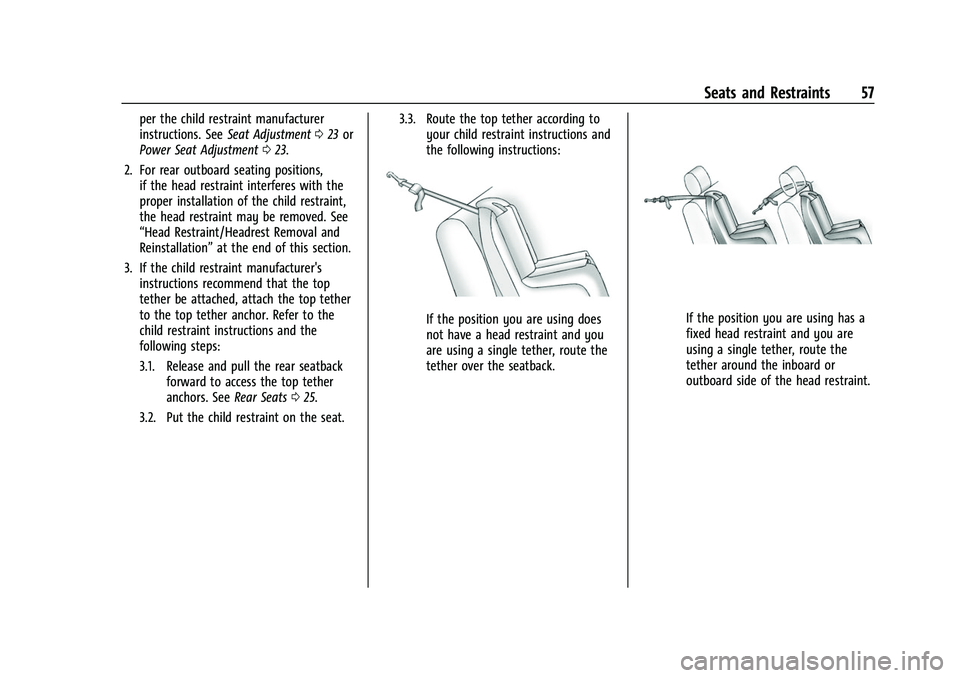
GMC Canyon/Canyon Denali Owner Manual (GMNA-Localizing-U.S./Canada-
14430430) - 2021 - CRC - 9/9/20
Seats and Restraints 57
per the child restraint manufacturer
instructions. SeeSeat Adjustment 023 or
Power Seat Adjustment 023.
2. For rear outboard seating positions, if the head restraint interferes with the
proper installation of the child restraint,
the head restraint may be removed. See
“Head Restraint/Headrest Removal and
Reinstallation” at the end of this section.
3. If the child restraint manufacturer's instructions recommend that the top
tether be attached, attach the top tether
to the top tether anchor. Refer to the
child restraint instructions and the
following steps:
3.1. Release and pull the rear seatback forward to access the top tether
anchors. See Rear Seats025.
3.2. Put the child restraint on the seat. 3.3. Route the top tether according to
your child restraint instructions and
the following instructions:
If the position you are using does
not have a head restraint and you
are using a single tether, route the
tether over the seatback.If the position you are using has a
fixed head restraint and you are
using a single tether, route the
tether around the inboard or
outboard side of the head restraint.
Page 59 of 359
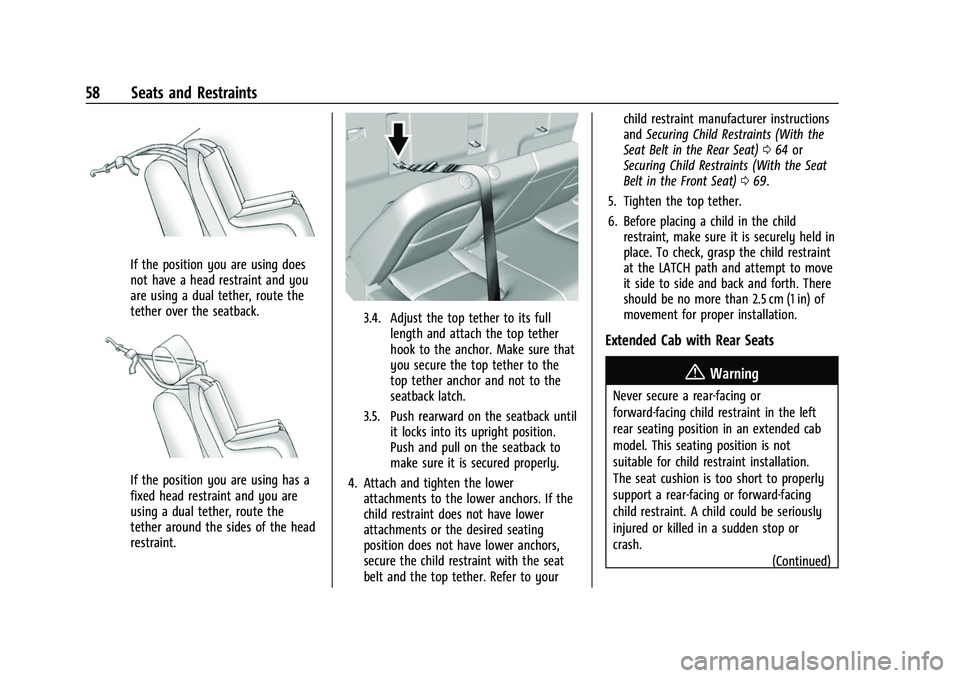
GMC Canyon/Canyon Denali Owner Manual (GMNA-Localizing-U.S./Canada-
14430430) - 2021 - CRC - 9/9/20
58 Seats and Restraints
If the position you are using does
not have a head restraint and you
are using a dual tether, route the
tether over the seatback.
If the position you are using has a
fixed head restraint and you are
using a dual tether, route the
tether around the sides of the head
restraint.
3.4. Adjust the top tether to its fulllength and attach the top tether
hook to the anchor. Make sure that
you secure the top tether to the
top tether anchor and not to the
seatback latch.
3.5. Push rearward on the seatback until it locks into its upright position.
Push and pull on the seatback to
make sure it is secured properly.
4. Attach and tighten the lower attachments to the lower anchors. If the
child restraint does not have lower
attachments or the desired seating
position does not have lower anchors,
secure the child restraint with the seat
belt and the top tether. Refer to your child restraint manufacturer instructions
and
Securing Child Restraints (With the
Seat Belt in the Rear Seat) 064 or
Securing Child Restraints (With the Seat
Belt in the Front Seat) 069.
5. Tighten the top tether.
6. Before placing a child in the child restraint, make sure it is securely held in
place. To check, grasp the child restraint
at the LATCH path and attempt to move
it side to side and back and forth. There
should be no more than 2.5 cm (1 in) of
movement for proper installation.
Extended Cab with Rear Seats
{Warning
Never secure a rear-facing or
forward-facing child restraint in the left
rear seating position in an extended cab
model. This seating position is not
suitable for child restraint installation.
The seat cushion is too short to properly
support a rear-facing or forward-facing
child restraint. A child could be seriously
injured or killed in a sudden stop or
crash.
(Continued)
Page 60 of 359
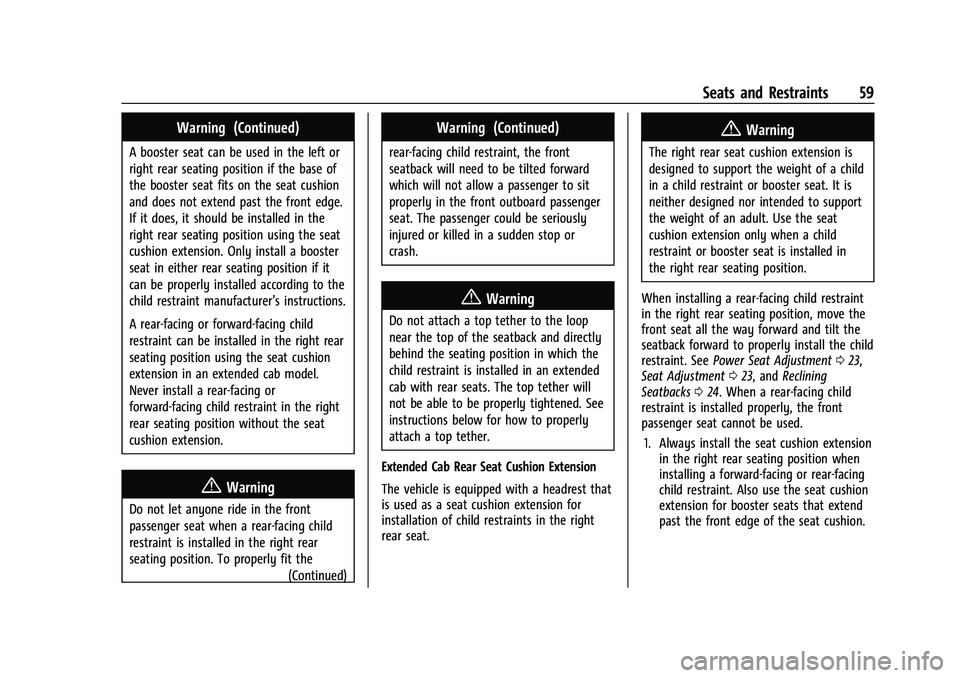
GMC Canyon/Canyon Denali Owner Manual (GMNA-Localizing-U.S./Canada-
14430430) - 2021 - CRC - 9/9/20
Seats and Restraints 59
Warning (Continued)
A booster seat can be used in the left or
right rear seating position if the base of
the booster seat fits on the seat cushion
and does not extend past the front edge.
If it does, it should be installed in the
right rear seating position using the seat
cushion extension. Only install a booster
seat in either rear seating position if it
can be properly installed according to the
child restraint manufacturer’s instructions.
A rear-facing or forward-facing child
restraint can be installed in the right rear
seating position using the seat cushion
extension in an extended cab model.
Never install a rear-facing or
forward-facing child restraint in the right
rear seating position without the seat
cushion extension.
{Warning
Do not let anyone ride in the front
passenger seat when a rear-facing child
restraint is installed in the right rear
seating position. To properly fit the(Continued)
Warning (Continued)
rear-facing child restraint, the front
seatback will need to be tilted forward
which will not allow a passenger to sit
properly in the front outboard passenger
seat. The passenger could be seriously
injured or killed in a sudden stop or
crash.
{Warning
Do not attach a top tether to the loop
near the top of the seatback and directly
behind the seating position in which the
child restraint is installed in an extended
cab with rear seats. The top tether will
not be able to be properly tightened. See
instructions below for how to properly
attach a top tether.
Extended Cab Rear Seat Cushion Extension
The vehicle is equipped with a headrest that
is used as a seat cushion extension for
installation of child restraints in the right
rear seat.
{Warning
The right rear seat cushion extension is
designed to support the weight of a child
in a child restraint or booster seat. It is
neither designed nor intended to support
the weight of an adult. Use the seat
cushion extension only when a child
restraint or booster seat is installed in
the right rear seating position.
When installing a rear-facing child restraint
in the right rear seating position, move the
front seat all the way forward and tilt the
seatback forward to properly install the child
restraint. See Power Seat Adjustment 023,
Seat Adjustment 023, and Reclining
Seatbacks 024. When a rear-facing child
restraint is installed properly, the front
passenger seat cannot be used.
1. Always install the seat cushion extension in the right rear seating position when
installing a forward-facing or rear-facing
child restraint. Also use the seat cushion
extension for booster seats that extend
past the front edge of the seat cushion.